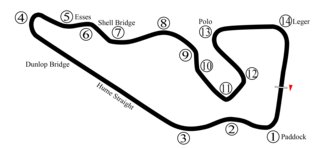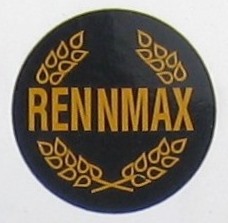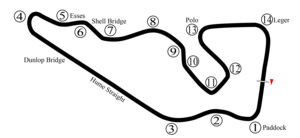
Repco is an Australian automotive engineering/retailer company. Its name is an abbreviation of Replacement Parts Company and it is best known for spare parts and motor accessories.

Formula 5000 was an open wheel, single seater auto-racing formula that ran in different series in various regions around the world from 1968 to 1982. It was originally intended as a low-cost series aimed at open-wheel racing cars that no longer fit into any particular formula. The '5000' denomination comes from the maximum 5.0 litre engine capacity allowed in the cars, although many cars ran with smaller engines. Manufacturers included McLaren, Eagle, March, Lola, Lotus, Elfin, Matich and Chevron.

The Brabham BT19 is a Formula One racing car designed by Ron Tauranac for the British Brabham team. The BT19 competed in the 1966 and 1967 Formula One World Championships and was used by Australian driver Jack Brabham to win his third World Championship in 1966. The BT19, which Brabham referred to as his "Old Nail", was the first car bearing its driver's name to win a World Championship race.
The Lotus 39 was a single-seat racing car produced by Team Lotus. It was originally intended for use in Formula One, to be powered by the Coventry Climax 1.5 litre flat-16 engine. The engine project fell through and the chassis was modified to accept a Climax 2.5 litre engine for the 1966 Tasman Series, in which Jim Clark finished in third place.
The 1964 Tasman Series was an international motor racing series contested in New Zealand and Australia over eight races beginning on 4 January and ending on 2 March. It was the first Tasman Series. The series, which was officially known as the Tasman Championship for Drivers, was organised jointly by the Association of New Zealand Car Clubs Inc. and the Confederation of Australian Motor Sport with the winning driver awarded the Tasman Cup. The championship was open to racing cars using unsupercharged engines of up to 2,500 c.c. capacity.
The 1967 Tasman Series was a motor racing competition open to racing cars complying with the Tasman Formula. Officially known as the Tasman Championship for Drivers, it was organised by the Motorsport Association, New Zealand Inc. and the Confederation of Australian Motor Sport and was contested over six races in New Zealand and Australia between 7 January and 6 March 1967.

The Longford Circuit was a temporary motor racing course laid out on public roads at Longford, 23 kilometres (14 mi) south-west of Launceston in Tasmania, Australia. It was located on the northern edges of the town and its 7 km lap passed under a railway line viaduct, crossed the South Esk River via the wooden Kings Bridge, turned hard right at the doorstep of the Longford Hotel, passed over the railway line using a level crossing and traversed the South Esk again via another wooden structure, the Long Bridge.

The 1967 Australian Grand Prix was a motor race held over 45 laps of the 3.621 km (2.25 mi) Warwick Farm Raceway in Sydney, New South Wales, Australia on 19 February 1967. The race, which was open to Australian National Formula and Australian 1½ Litre Formula cars, had 15 starters.

The 1968 Australian Grand Prix was a motor race held at Sandown Park in Victoria, Australia on 25 February 1968. The race was open to Racing Cars complying with the Australian National Formula or the Australian 1½ Litre Formula. It was the thirty third Australian Grand Prix and was also round seven of the 1968 Tasman Series. The race was staged by the Light Car Club of Australia and was sponsored by the Royal Automobile Club of Victoria.
The 1966 Australian Drivers' Championship was a CAMS sanctioned Australian motor racing title for drivers of racing cars complying with either the Australian National Formula or the Australian 1½ Litre Formula. The winner of the title, which was the tenth Australian Drivers' Championship, was awarded the 1966 CAMS Gold Star.
The 1970 Australian Drivers' Championship was a CAMS sanctioned motor racing title for drivers of Australian Formula 1 and Australian Formula 2 racing cars. The winner of the title, which was the fourteenth Australian Drivers' Championship, was awarded the 1970 CAMS Gold Star.
The Matich name was applied to a series of sports racing cars and open wheel racing cars produced in Australia between 1967 and 1974 under the direction of Sydney-based racing driver and engineer Frank Matich.
The 1965 Australian Drivers' Championship was a CAMS sanctioned Australian national motor racing title open to racing cars complying with the Australian National Formula or the Australian 1½ Litre Formula. The title was contested over a six race series with the winner awarded the 1965 CAMS Gold Star. It was the ninth Australian Drivers' Championship.
The 1967 Australian Drivers' Championship was an Australian motor racing competition open to Australian National Formula cars and Australian 1½ Litre Formula cars. It was authorised by the Confederation of Australian Motor Sport (CAMS) as an Australian National Title with the winner awarded the 1967 CAMS Gold Star. It was the 11th Australian Drivers' Championship to be awarded by CAMS.
The 1969 Australian Drivers' Championship was a CAMS sanctioned Australian motor racing title for drivers of cars conforming to Australian National Formula or Australian Formula 2 regulations. The championship was contested over a six race series with the winner awarded the 1969 CAMS Gold Star. It was the thirteenth Australian Drivers' Championship to be awarded by CAMS.

The Rennmax name was applied to a series of open wheel racing cars and sports racing cars constructed by Rennmax Engineering in Sydney, Australia between 1962 and 1978. Rennmax Engineering was established by Bob Britton in 1961, its name derived from the German word "Renn", meaning race and the abbreviation "max", for maximum.

The Brabham BT3 is a Formula One racing car. It was the first Formula One design to be produced by Motor Racing Developments for the Brabham Racing Organisation, and debuted at the 1962 German Grand Prix. The Brabham BT3 was the vehicle with which team owner – then two-time World Champion – Jack Brabham, became the first driver ever to score World Championship points in a car bearing his own name, at the 1962 United States Grand Prix. The following year Brabham also became the first driver ever to win a Formula One race at the wheel of an eponymous car, again driving the BT3, at the 1963 Solitude Grand Prix. The BT3 design was modified only slightly to form the Tasman Series-specification Brabham BT4 cars.
The Mildren name was used on a series of racing vehicles constructed for, or acquired by, Australian racing team owner Alec Mildren during the 1960s and early 1970s.

The 1961 International 100 was a motor race staged at the Warwick Farm Raceway in New South Wales, Australia on 29 January 1961. Contested as a Formula Libre race, it was staged over a distance of 101.25 miles and was the first annual International 100 race to be held at Warwick Farm.

The Brabham BT5, and its evolution, the Brabham BT8, are sports racing cars manufactured and developed by Brabham in 1963 (BT5) and 1964 (BT8), respectively. It won a total of 4 races, and achieved 10 podium finishes.









